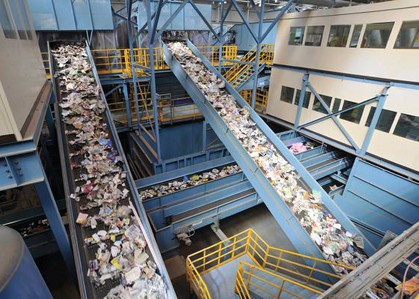The Environment Committee of the European Parliament has been applauded for adopting an amendment to the European Commission’s Circular Economy Package that would set a 70% recycling target for municipal waste in 2030, as opposed to 65% as the Commission proposed. But analysis of related changes the Committee voted through suggests this praise is unmerited.

When setting targets it is vital they can be measured accurately and consistently, to ensure harmonised reporting. This is not the case with the EU’s current target to recycle 50% of household and similar waste by 2020. Member States can measure any one of four different things – recycling rates for all municipal waste, or for all household waste (the UK method), or for paper metal plastic and glass in household waste, either individually or collectively. Moreover Member States can and do use different measurement points – either the input to sorting stage, the output of sorting stage, or the input to recycling facilities. This has led to justifiable criticism that Member States’ currently reported recycling rates are not comparable.
The European Commission’s Circular Economy proposals addressed this issue pragmatically when setting higher EU recycling targets for 2025 and 2030. Firstly, the Commission proposed that the recycling rate to be measured would be for all municipal waste, not for household waste or any other subset, based on a uniform definition of municipal waste. Secondly, the Commission proposed that the point of measurement should be the input to the final recycling process, or, by way of derogation, the output of a sorting operation provided it is sent to a final recycling process.
Adoption of these Commission proposals would result in a significant improvement in the comparability of recycling rates reported by Member States, while recognising the practicalities of recycling. Critics however, including MEPs on the Environment Committee, argue that absolute harmonisation is paramount and that the only point of measurement permitted should be the input to final recycling. So the Environment Committee voted to remove the option of measurement at the output of sorting stage.
Calculation
ESA, FEAD and many others think this is wrong. Using the input to final recycling as the calculation point can work well for waste streams such as food waste and garden waste, which after collection are often delivered straight to composting or anaerobic digestion plants. However it works much less well, if at all, for dry recyclable materials which are separately or co-collected and sorted one or more times depending on the specification required. They may be handled by one or more intermediaries prior to arrival at the final recycling stage, which can often be in a different country from the one where the waste was collected, and may be outside the EU altogether.
“Using the input to final recycling as the calculation point can work well for waste streams such as food waste and garden waste, which after collection are often delivered straight to composting or anaerobic digestion plants. However it works much less well, if at all, for dry recyclable materials which are separately or co-collected and sorted one or more times depending on the specification required.”
Roy Hathaway
ESA
Under the Environment Committee’s proposal, Member States which do not have a full range of final recycling facilities would be reliant on reporting back from other countries to calculate their recycling rates. At the point at which dry recyclables such as metals, paper and plastic enter final recycling they may have been mixed with materials from non-municipal sources and from other countries. It is asking a lot of the traceability systems in other Member States – let alone those outside the EU – to expect them to report accurate MW recycling data back to the country where the waste originated.
The realities of recycling data collection are recognised by Eurostat in its Guidance on Municipal Waste Data Collection (2012). Section 4 (Scope and coverage of municipal waste treatment) notes that: “…. the input to the “final” processes is often not known. Instead the data collection covers, at least partly, only the inputs and/or outputs of the preparation processes that divert non-recyclable or non-compostable residues from the main stream to be recycled or composted.”
Sorting
That is why the Commission were correct to propose an alternative to calculating the recycling rate at the input to final recycling, namely measurement at the output of sorting stage. The way the Commission proposed to do this may need some tweaking. Rather than allowing any sorting output where more than 90% of the material goes to recycling to count as 100% recycled, it would be better to measure the actual proportion of the output which is destined for recycling.

This calculation point should not be a mere derogation, but an equal alternative to the input to final recycling, because it is better suited to some waste streams in terms of traceability and reporting. Ideally the Commission will adopt detailed rules at a later stage setting out the optimum measurement points for the main recyclable materials present in municipal waste.
There is another reason why the MEPs’ amendment to the recycling calculation point is unhelpful and unrealistic. It is common ground amongst experts that if it was possible to measure municipal waste recycling rates in the way the Environment Committee suggests – solely by reference to the weight of material entering the final recycling process – then some Member States’ reported recycling rates would be up to 20% lower than they are now. This would make achievement of a 70% recycling target by 2030 completely impossible, even for the best performing Member States. Put simply, a 65% or 70% target only makes sense with a calculation method which allows measurement at the output of sorting stage alongside measurement at the input to final recycling.
Circular Economy
Since the municipal waste recycling rate for 2030 has become the touchstone for the entire Circular Economy Package – wrongly in my view, since the focus should be on waste prevention – this argument matters. The Environment Committee’s position is incoherent, and ought to be overturned by the Plenary vote in the European Parliament, or by the Commission and the Council during the Trilogue discussions. Or perhaps Brexit will make it irrelevant from a UK perspective?











Subscribe for free